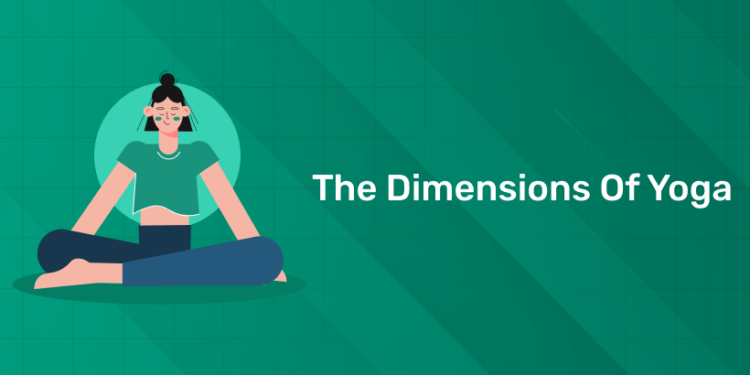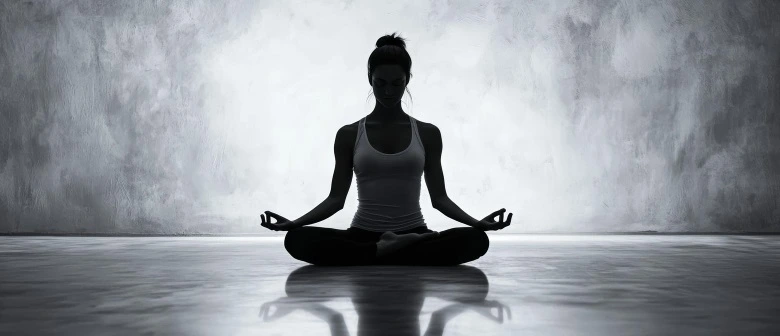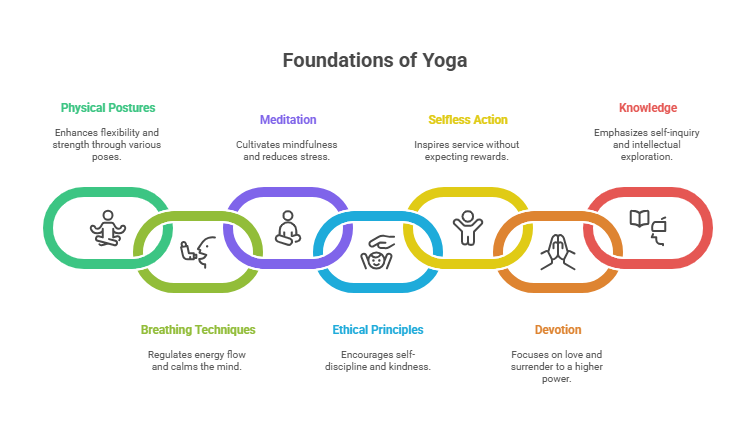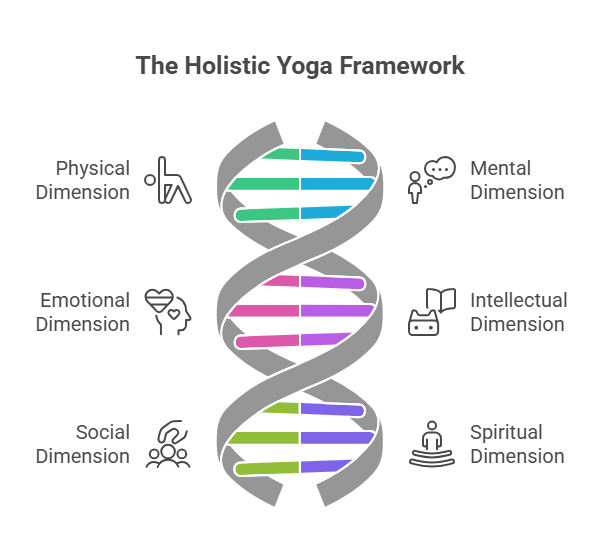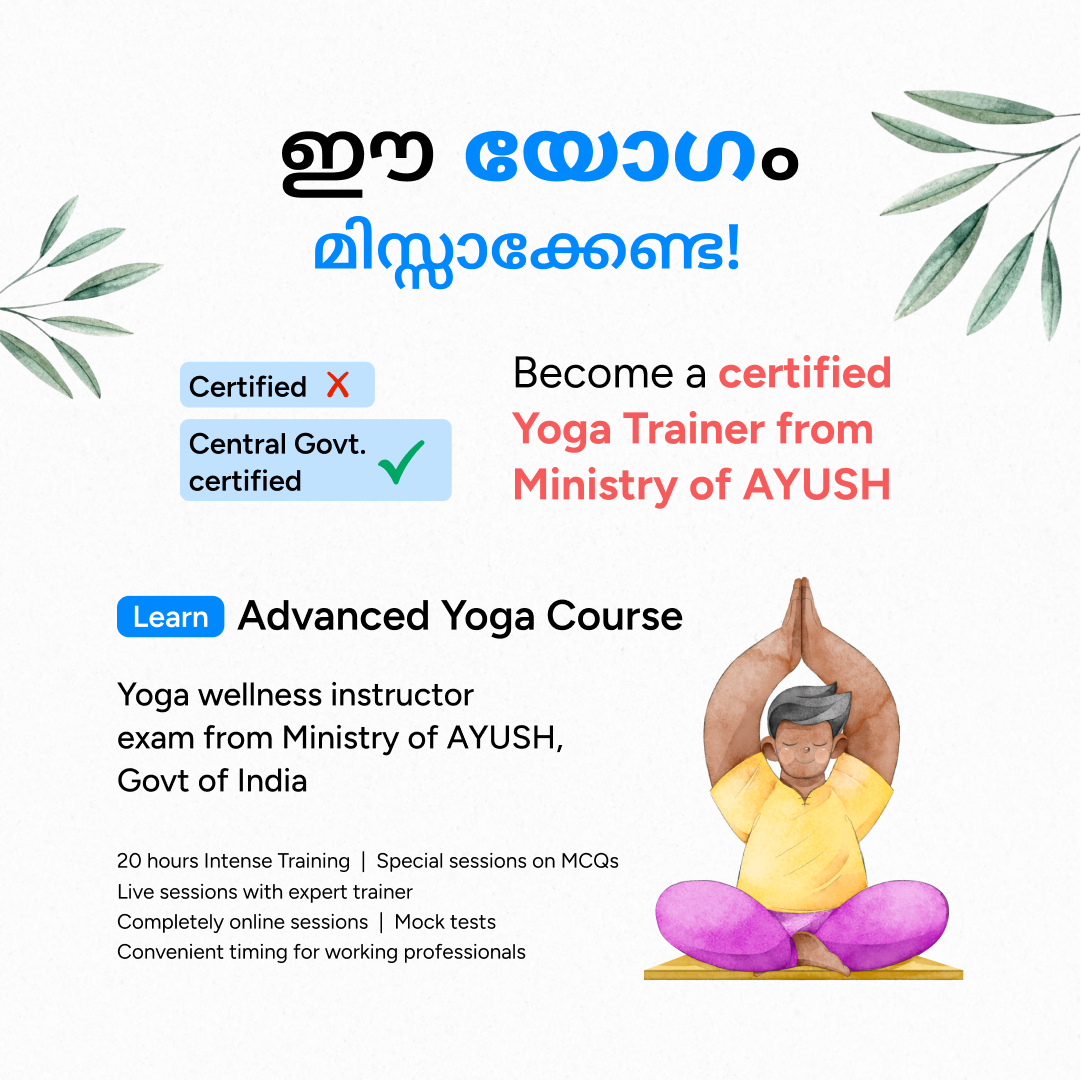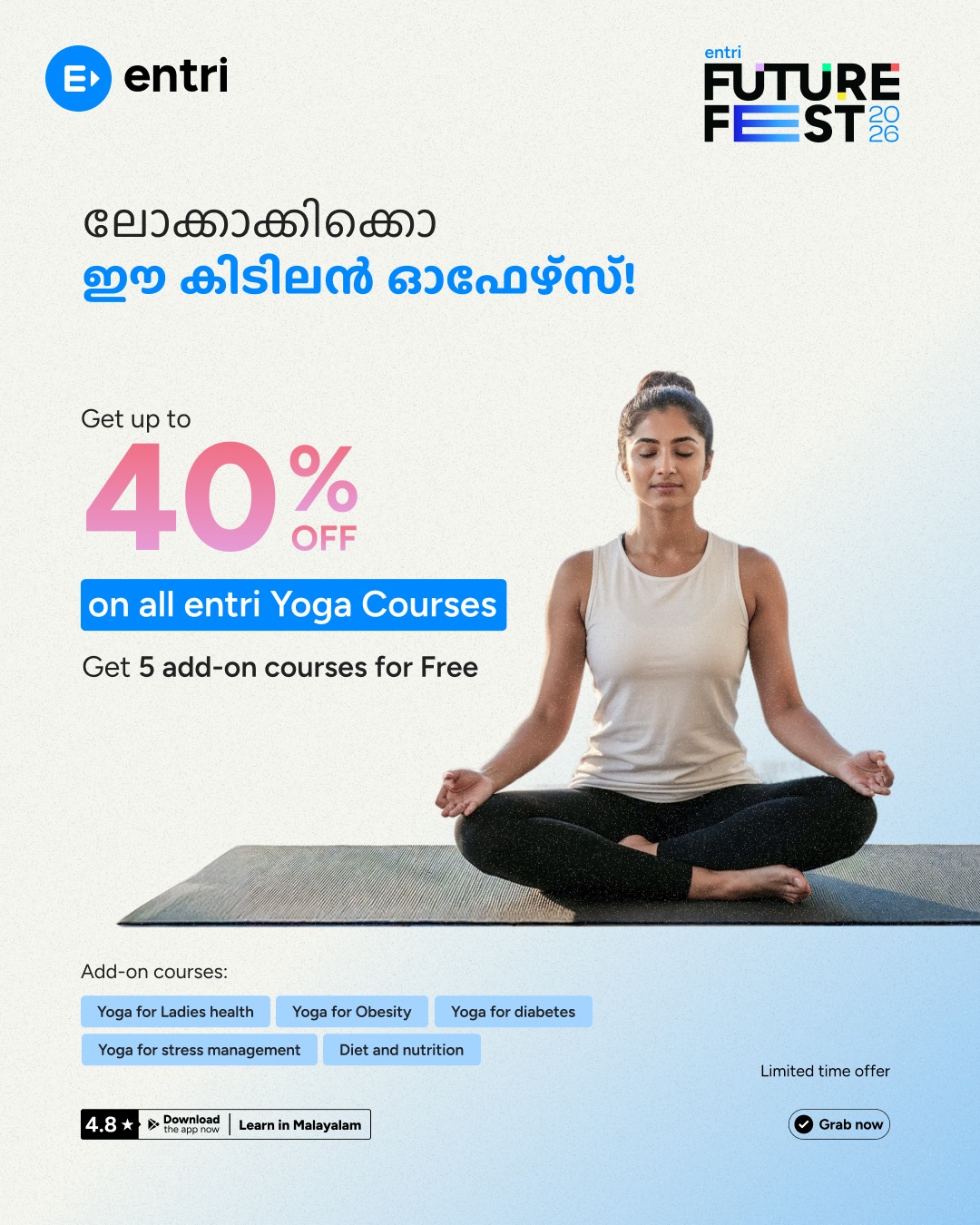Table of Contents
Yoga, an ancient practice with modern relevance, has evolved as a holistic approach to health and well-being. Rooted in Indian philosophy, yoga is much more than physical exercise. It is a way of life that connects the body, mind, and soul. In this blog, we’ll explore the dimensions of yoga, its essence and how it continues to inspire millions worldwide.
Want to learn Yoga? Want to become a Yoga trainer? Start your journey today!
What is Yoga?
Yoga is an ancient practice that unites the body, mind, and spirit, fostering harmony and balance in life. Originating in India over 5,000 years ago, yoga has evolved into a universal system that transcends cultural and geographical boundaries. While many associate yoga with physical postures (asanas), it is a much broader discipline that integrates movement, breathing, meditation, and ethical living.
The Meaning of Yoga
The word yoga comes from the Sanskrit root “Yuj,” which means to join, yoke, or unite. This union refers to the integration of:
- Body and Mind: Cultivating physical health and mental clarity.
- Individual and Universal Consciousness: Achieving a deeper connection with the world and a higher power.
- Inner Harmony: Aligning thoughts, emotions, and actions.
In essence, yoga is a path to self-awareness, helping individuals live with greater purpose and peace.
The Philosophy Behind Yoga
Yoga is rooted in ancient Indian philosophy and is outlined in classical texts such as the:
- Vedas: Earliest Indian scriptures that reference yogic practices.
- Upanishads: Philosophical texts that explore meditation and self-realization.
- Bhagavad Gita: A spiritual guide that discusses the practice of yoga in daily life.
- Yoga Sutras of Patanjali: A foundational text that defines yoga as the cessation of mental fluctuations (Chitta Vritti Nirodha). It lays out an eightfold path, or Ashtanga Yoga, guiding individuals toward self-mastery and enlightenment.
Its Key Elements
Yoga encompasses various practices, each addressing different aspects of human existence:
1. Physical Postures (Asanas)
- Improve flexibility, strength, and balance.
- Enhance overall health and reduce the risk of chronic diseases.
2. Breathing Techniques (Pranayama)
- Regulate the flow of vital energy (prana).
- Calm the mind and improve focus.
3. Meditation (Dhyana)
- Cultivates mindfulness and inner peace.
- Reduces stress, anxiety, and depression.
4. Ethical Principles (Yamas and Niyamas)
- Encourage self-discipline, kindness, and a harmonious lifestyle.
- Lay the foundation for meaningful personal growth.
5. Selfless Action (Karma Yoga)
- Inspires service to others without attachment to results.
6. Devotion (Bhakti Yoga)
- Focuses on love and surrender to a higher power.
7. Knowledge (Jnana Yoga)
- Emphasizes self-inquiry and intellectual exploration to uncover truth.
Modern Relevance of Yoga
In today’s fast-paced world, yoga has gained immense popularity as a tool for enhancing well-being. It is widely practiced for its ability to:
- Relieve stress and anxiety.
- Improve physical health and posture.
- Boost mental focus and emotional stability.
- Encourage a balanced and mindful way of living.
Yoga is more than an exercise routine; it is a philosophy and a way of life. By integrating its practices into your daily routine, you can foster a healthier body, a calmer mind, and a deeper connection with your true self. Whether you are a beginner or a seasoned practitioner, yoga offers endless possibilities for growth and transformation.
Embark on this journey, and discover the transformative power of yoga in your life.
Want to learn Yoga? Want to become a Yoga trainer? Start your journey today!
The Dimensions of Yoga
1: Which of these is the primary goal of yoga practice?
Yoga is a holistic discipline that extends far beyond physical postures. Its essence lies in achieving harmony within oneself and with the world around us. To fully grasp the depth of yoga, it is essential to understand its various dimensions, each of which caters to different aspects of human existence. These dimensions guide individuals toward physical health, mental clarity, emotional balance, and spiritual awakening.
1. Physical Dimension (Kaya Yoga)
The physical dimension is the foundation of yoga, focusing on maintaining and enhancing the health and vitality of the body. It serves as the starting point for most practitioners and provides the groundwork for exploring the deeper dimensions of yoga.
Key Components:
- Asanas (Postures): These are specific physical poses designed to stretch, strengthen, and balance the body. Examples include foundational poses like Mountain Pose (Tadasana), dynamic poses like Sun Salutations (Surya Namaskar), and restorative poses like Child’s Pose (Balasana).
- Breath Synchronization: Many asanas involve coordinating movements with controlled breathing, promoting a sense of calm and focus.
Benefits:
- Improved Physical Health:
- Enhances flexibility, strength, and balance.
- Boosts blood circulation and improves cardiovascular health.
- Strengthens the immune system, aiding in disease prevention.
- Management of Chronic Conditions:
- Alleviates pain from conditions like arthritis, back issues, and joint stiffness.
- Regulates blood pressure, aiding those with hypertension.
- Helps manage obesity, diabetes, and other lifestyle-related disorders.
- Enhanced Energy Levels: Regular practice revitalizes the body and reduces fatigue, promoting sustained energy throughout the day.
This dimension of yoga not only improves physical fitness but also sets the stage for mental clarity and emotional resilience, enabling a holistic approach to well-being.
2. Mental Dimension (Manas Yoga)
The mental dimension of yoga addresses the mind, focusing on calming its fluctuations and improving mental clarity. It helps practitioners cultivate mindfulness and resilience, enabling them to face life’s challenges with equanimity.
Key Components:
- Pranayama (Breath Control): Breathing exercises such as Nadi Shodhana (alternate nostril breathing) and Kapalabhati (cleansing breath) calm the mind and regulate emotions.
- Meditation (Dhyana): Practices like mindfulness meditation or guided visualizations reduce stress and foster mental focus.
- Relaxation Techniques: Yoga Nidra (yogic sleep) and other relaxation practices promote mental rest and rejuvenation.
Benefits:
- Stress and Anxiety Reduction:
- Calms the nervous system, reducing feelings of overwhelm.
- Enhances the ability to respond thoughtfully to stressors.
- Enhanced Cognitive Function:
- Improves concentration, memory, and decision-making.
- Encourages creative thinking and problem-solving.
- Emotional Regulation:
- Reduces emotional volatility and fosters inner balance.
- Enhances resilience against mental health challenges like depression and burnout.
This dimension lays the groundwork for emotional stability and intellectual growth, allowing practitioners to achieve a state of mental peace and focus.
3. Emotional Dimension (Bhakti Yoga)
The emotional dimension of yoga focuses on nurturing love, compassion, and devotion. It emphasizes connecting with the heart and channeling emotions toward positive and fulfilling expressions.
Key Components:
- Devotional Practices: Chanting mantras, singing devotional songs (kirtans), and engaging in prayer are ways to express love and gratitude.
- Cultivation of Compassion: Developing empathy and understanding fosters healthy relationships.
- Surrender to a Higher Power: Letting go of ego and control allows for emotional release and inner peace.
Benefits:
- Emotional Healing:
- It provides an outlet for processing and releasing negative emotions.
- Cultivates forgiveness and emotional resilience.
- Stronger Relationships:
- Encourages empathy, improving interactions with others.
- Deepens bonds with loved ones and the community.
- Inner Fulfillment:
- Promotes a sense of purpose and belonging.
- Inspires joy and contentment from within.
This dimension allows practitioners to channel emotions positively, creating harmony within themselves and their relationships.
4. Intellectual Dimension (Jnana Yoga)
The intellectual dimension of yoga engages the mind in the pursuit of wisdom and self-realization. It is a path of knowledge that leads to a deeper understanding of life’s mysteries and one’s true nature.
Key Components:
- Self-Inquiry: Asking existential questions such as “Who am I?” and “What is my purpose?” leads to self-awareness.
- Study of Sacred Texts: Scriptures like the Upanishads, Bhagavad Gita, and Yoga Sutras provide insights into universal truths.
- Philosophical Reflection: Encourages detachment from ignorance and superficial desires to uncover deeper truths.
Benefits:
- Expanded Awareness:
- Encourages critical thinking and intellectual curiosity.
- Fosters a deeper understanding of oneself and the world.
- Dissolution of Ignorance:
- Reduces attachment to materialism and ego-driven pursuits.
- Promotes clarity and discernment in decision-making.
- Path to Enlightenment:
- Guides individuals toward spiritual truths and ultimate liberation.
This dimension is particularly suited for those seeking intellectual and philosophical growth, providing clarity and alignment with higher truths.
5. Social Dimension (Karma Yoga)
The social dimension of yoga emphasizes selfless service and ethical action, focusing on living in harmony with others and contributing positively to society.
Key Components:
- Selfless Action: Engaging in acts of kindness without expecting recognition or rewards.
- Performing Duties: Approaching responsibilities with diligence and integrity.
- Community Engagement: Building empathy and fostering social harmony through service.
Benefits:
- Personal Growth:
- Reduces ego and fosters humility.
- Encourages a life of purpose and meaning.
- Strengthened Social Bonds:
- Promotes cooperation and understanding in communities.
- Encourages acts of kindness and compassion.
- Improved Emotional Fulfillment:
- Brings joy and satisfaction from helping others.
- Encourages a sense of connection and belonging.
By emphasizing altruism and ethical living, this dimension enhances the quality of one’s relationships and fosters a life of integrity and contribution.
6. Spiritual Dimension (Raja Yoga or Dhyana Yoga)
The spiritual dimension is the ultimate goal of yoga, focusing on self-realization and the connection to universal consciousness. It seeks to transcend material existence and uncover the true essence of being.
Key Components:
- Meditation and Contemplation: Practices like deep meditation (Samadhi) and mindful awareness foster spiritual connection.
- Union with the Divine: Achieving harmony with universal consciousness or a higher power.
- Liberation (Moksha): Freedom from material attachments and the cycle of birth and death.
Benefits:
- Inner Peace:
- Provides a sense of calm and contentment that is not dependent on external circumstances.
- Offers clarity about life’s purpose.
- Spiritual Fulfillment:
- Cultivates a deep connection with the divine or universal energy.
- Guides practitioners toward enlightenment.
- Freedom from Ego:
- Reduces attachment to materialism and individualism.
- Encourages humility and selflessness.
This dimension represents the pinnacle of yoga, guiding individuals toward profound self-awareness and eternal peace.
Interdependence of Dimensions
The dimensions of yoga are deeply interconnected, each complementing the others:
- Physical health supports mental clarity.
- Emotional stability fosters intellectual growth.
- Social engagement enhances spiritual well-being.
Together, these dimensions create a balanced and integrated approach to living, offering individuals the tools to lead fulfilling and harmonious lives.
Become a Certified Yoga Instructor
Yoga Teacher Training Course by Entri App: Master authentic yoga techniques, earn certification, and build a successful career as a professional yoga instructor.
Join Now!Applying This Understanding in Modern Life
In today’s fast-paced world, yoga’s depth is more relevant than ever. It’s not necessary to retreat to a cave or give up modern life to experience its benefits. Even simple shifts make an impact:
-
Five minutes of focused breathing before meetings.
-
A short meditation before bed.
-
Reflecting on one Yama per week.
-
Choosing calm responses over reactive ones.
Yoga doesn’t ask for perfection. It asks for practice with honesty and patience.
The Dimensions of Yoga: Conclusion
The dimensions of yoga reflect its profound wisdom and versatility as a life practice. Whether you seek physical strength, emotional resilience, intellectual clarity, or spiritual awakening, yoga provides a tailored path to meet your needs. By embracing all its dimensions, you can embark on a transformative journey toward self-discovery, balance, and enlightenment.
Yoga is not just a practice; it is a way of life, offering guidance at every stage of your personal and spiritual evolution.
Become a Certified Yoga Instructor
Yoga Teacher Training Course by Entri App: Master authentic yoga techniques, earn certification, and build a successful career as a professional yoga instructor.
Join Now!Frequently Asked Questions
Can anyone practice yoga, regardless of age or fitness level?
Yes! Yoga is inclusive and adaptable. Beginners can start with simple poses and gradually move to more advanced practices under proper guidance.
How often should one practice yoga?
Consistency is key. Practicing yoga 3-5 times a week, even for 20-30 minutes, can yield significant benefits.
Is yoga a religion?
No, yoga is not a religion. While it has spiritual roots, yoga is a philosophy and practice open to people of all faiths and beliefs.
What equipment is needed for yoga?
A yoga mat, comfortable clothing, and a peaceful space are all you need to start your yoga journey.
Can yoga help improve sleep?
Yes, yoga can significantly improve sleep quality. Practices like Yoga Nidra, restorative yoga, and gentle evening routines relax the body and mind, helping you unwind and prepare for restful sleep.
By addressing these common questions, yoga becomes accessible and understandable to practitioners of all levels, inspiring confidence and enthusiasm to embark on this transformative journey.
Are there any risks associated with yoga?
Yoga is generally safe when practiced correctly, but incorrect postures or overexertion can lead to injuries. It’s crucial to learn from a qualified instructor, especially when starting out or attempting advanced poses.
Can yoga be practiced during pregnancy?
Yes, prenatal yoga is specifically designed for pregnant women, focusing on gentle poses, breathing exercises, and relaxation techniques. However, it’s essential to consult with a healthcare provider and practice under a trained instructor.
Can yoga help with weight loss?
Yes, yoga can contribute to weight loss by increasing physical activity, improving metabolism, and reducing stress-related overeating. Dynamic styles like Vinyasa or Power Yoga are particularly effective for burning calories, while practices like mindfulness and pranayama encourage healthy habits.
How is yoga different from other forms of exercise?
Unlike traditional exercise, yoga integrates physical movement, breath control, and mindfulness. It not only builds physical strength and flexibility but also promotes mental clarity, emotional balance, and spiritual growth.
What should I eat before practicing yoga?
It’s best to practice yoga on an empty stomach or at least 2-3 hours after a meal. If you need to eat beforehand, opt for a light snack like fruit, yogurt, or a handful of nuts.


